|
Related FAQs: Marine Invertebrates,
Marine Invert.s
2, Marine Invert.s 3,
Non-Vert IDs 1,
Non-Vert IDs 2, Non-Vert IDs 3, Non-Vert IDs 4, Non-Vert IDs 5, Non-Vert IDs 6, Non-Vert IDs 7, Non-Vert IDs 8, Non-Vert IDs 9, Non-Vert IDs 10,
Non-Vert IDs11,
Non-Vert IDs 12,
Non-Vert IDs 13,
Non-Vert IDs 14,
Non-Vert IDs 15,
Non-Vert IDs 16,
Non-Vert IDs 17,
Non-Vert IDs 18, Non-Vert. ID 19, Non-Vert. ID 20, Non-Vert. ID 21, Non-Vert. ID 25,
Non-Vert ID 26, Non-Vert ID 27, Non-Vert ID 28, Non-Vert ID 29, Non-Vert ID 30 Non-Vert ID 31, Non-Vert ID 32, Non-Vert 33, Non-Vert ID 34, Non-Vert ID 35, Non-Vert ID 36, Non-Vert ID 37, Non-Vert ID 38, Non-Vert ID
39, Non-Vert ID 40,
Non-Vert ID 41,
Non-Vert ID 42, & FAQs
about: Marine Invertebrate
Behavior, Marine
Invertebrate Compatibility, Marine Invertebrate Selection,
Marine Invertebrate
Systems, Feeding Reef
Invertebrates, Marine
Invertebrate Disease, Marine Invertebrate
Reproduction, &
Quarantine of Corals and
Invertebrates, Feeding Reef Invertebrates,
Lighting Marine
Invertebrates, Marine
Plankton, Marine
Microbes, Marine Virus,
Marine Bacteria,
Marine Funguses, Marine Protozoans,
Marine Plankton, Live Rock,
Related Articles: Marine Virology, Marine Bacteria, Marine Mycology,
Marine Protozoans,
Invertebrates, Marine Plankton, Live
Rock, Live Sand, Sponges (Porifera), Stinging-Celled Animals (Cnidaria),
Worm Groups, Mollusks (Snails, Bivalves, Octopus...),
Pycnogonids (Sea Spiders),
Jointed-Legged
Animals (Arthropods), Bryozoans/Ectoprocts, Spiny-Skinned Animals
(Echinoderms), Water Flow, How Much
is Enough,
10 Most Surprising Aquarium Hitchhikers (Good and Bad)
|
|
|
By Bob Fenner
|
|
Let’s face it, sometimes surprises
can be fun; you know, like unexpected birthday parties. As aquarists
though, incidents where “freebies” coming in and on other new purchases,
rarely elicits squeals of “oh joy”! Most such hitchhikers are unwelcome
guests; causing sprints for online help and guru advice on how to remove
them. I urge you to not be over-hasty; in most cases these “bonus”
organisms aren’t immediately dangerous… well, and to do the usual
isolation/quarantine of all new livestock (including live rock and sand)
to ferret out undesirables; otherwise starve them into revealing
themselves, and granting you the opportunity to control them BEFORE
introduction to your main/display system/s.
Like going to the dentist, it’s so much easier, even fun to chat about
these hitchhikers, rather than to have to deal with them ourselves.
Herein is my take on the most surprising marine aquarium hitchhikers;
with notes on their control and possible elimination.
Wherefore Art Thou HHs?
First off, as you likely know, there are literally no ends of
co-travelers with the livestock we acquire. For our purposes here we’re
going to omit infectious microbes and parasites (thank you), and focus
on the likely macro-life folks have to deal with saltwater hobbyists.
Principal Sources: Hard Substrates
Anything wet can be a vector for introducing a hitchhiker to your
system; yes; anything wet. By propensity and diversity of such
introductions though, nothing exceeds hard substrates as diaspora media.
Live rock, live sands, hard bases that stony, soft corals, gorgonians
and more are shipped with are the super bonus of HH origins.
|
Oh so subtle, even sublime, as it
lulls you into a false sense of
security. Live rock and sand… actually
any hard material collected in the wild,
or not… that has been exposed to
material collected in the wild may well
harbour snails, worms, crustaceans,
algae… and MUCH more.
All new
purchases should be isolated,
quarantined for a few weeks: to give you
time to examine for HHs, starving them
out to reveal them. Besides, some curing
may need to process.
|

|
|

|
Unless the live rock is man-made,
artificial, it WILL have other life
coming on and in it. Here is a view of
some of the area where Walt Smith
International produces their artificial
product. They are also the largest
provider of the wild product; and do a
thorough job of cleaning and spritzing
newly cleaned rock to remove the bulk of
hitchhikers. I’ve seen literally pounds
of worms under their rinse troughs, and
all other marine fauna found in shallow
water, including moray eels!
|
Worms! Tah Dah; Let the Games Begin!
|
Vermes! Almost all phyla of worms
can be imported along with hard
substrates: From our fave Bristle-
aka Fire-worms (Errantiate
Polychaete Annelids); these can also
start small on immotile invertebrate
purchases (oh boy!). Below, a HH on a
nice gorgonian, an Amphinomid out for a
hike, and some small species doing their
thing in aquarium substrate, and out and
about on the surface.
|
|

|

|
|

|

|
|
In the mid eighties to about the
latter 1990’s hobbyists were inclined to
lose their proverbial minds re the
presence of these spiky segmented worms.
In actuality, unless there are too many,
or they’re too large to get along with
your other livestock, Bristleworms are
more beneficial than harmful; so,
hitchhiking worms can be a very good
thing. IF you have too many, there’s
something wrong with your
operation/maintenance. Mainly, too much
food is going into the system. Vacuum
the substrate, move the rocks if need be
to get around them, consider baiting,
trapping and removing a portion of the
wormy herd; and don’t fret. Oh, do watch
your hands… those podial spines are the
Dickens to get stuck by.
Hard to
avoid having at least some worm life in
a healthy marine system; so… isolate new
hard substrates, bait out too large
specimens, and don’t sweat the small
ones.
|
Algae: Some Good, Most Innocuous, a Few….
|
Algae are everywhere in aquatic
environments; coming in and on hard
substrates, in water with other
livestock, heck, even as spores
thousands of miles from oceans. Most are
good news; using up, accumulating
nutrients, some of which are otherwise
or become toxic metabolites,
synthesizing them into food for Protists
to Vertebrates. What you want to be
aware of is the settings which drive
desirable forms and the ones that allow
proliferation of undesirables, like most
blue greens; aka Cyanobacteria.
Immediately below, a mis of mostly
Green, Red and Brown macro-algae species
in Cozumel. Below lower; principally
desirable encrusting Reds (Corallines)
and next to it slimy, unwanted BGA,
which can be red, brown, green….
|
|

|
|

|

|
|
High, consistent biomineral
(Calcium and Magnesium mostly) and
Alkalinity are key to promoting wanted
over unwanted algae situations; coupled
with competition from other purposeful
photosynthetic life you keep,
restricting the introduction coupled
with export of excess nutrients, and use
of specific algae eating organisms are
the overall equation to balanced
systems. IF your system gets out of
balance; low RedOx, skewed chemistry,
pest algae proliferating, look to your
water quality, maintenance practices of
set up period. Consider adding a DSB,
macro-algal culture in an RDP refugium
setting…. Stepping up your water change
and gravel vacuuming programs.
|
Whose That Snapping Up My Wall?
|
Oh, let’s have a grouping of the
big three groups of less than desirable
Crustaceans that too often hitch a ride
in with other hard substrates: Yes, it’s
not Rice Crispies snap, crackling and
popping unfortunately; but Crabs, Pistol
Shrimps and Mantis that all-too often
are hiding out by day, scouring your
system stealthily by night, eating your
other livestock! At right, a Mitrax
forceps coming out at night in Bonaire.
Below; good-looking for still a Pistol,
Alpheus soror, and a nice Odontodactylus
scyllarus in the wild.
|

|
|

|

|
|
Best to be on the look out for
these jointed legged critters when you
introduce hard items, and to still keep
vigilant as your system matures. Their
easily excluded through quarantine of
new materials, and most can be otherwise
baited and trapped in an up and going
tank.
|
Snails!
|
Snails, like the insects that are
beetles are faves of creators, there
being so many species of them. Though
most are no trouble in captivity, some
coming in on live rock et al hard
materials are overtly predaceous, even
potentially dangerous to you, the
hobbyist. Experienced reefers will be
familiar with Heliacus, Box or Sundial
Snails; and other predaceous species.
How ‘bout the one at right? Yep; this is
a Textile Cone; Conus textilus; a fish
eater and dangerous to humans.
|
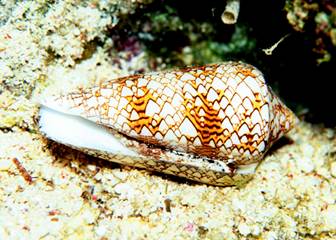
|
Even Spiny Skinned Animals?!!!
|
Most folks don’t object to a
freebie sea urchin, but some HH seastars
can become population bombs in their own
right. To wit, the oh-so-cute Asterina
stars (at right) and some brittlestars
(Ophiocoma, below). Little appreciated
is that Ophiuroids are definitive
animals in shallow to abyssal seas,
often determining what other life can
and does live there. You don’t want too
many of these. Bait/trap them out by
night and/or physically remove them.
|

|
|
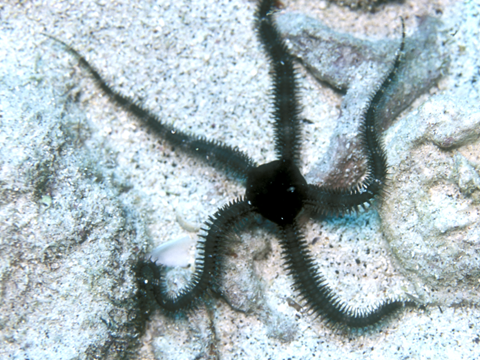
|
The “Pro” Side of Hard Substrate Hitchhikers: MANY!
|
Cheer up sunshine; it’s not all
gloom and doom when using natural live
rock, wild-collected live sand and
attached immotile livestock. Very many
good microbes, aerobic and not, algaes
of all sorts are introduced there in.
Some of our faves include encrusting Red
algae (as at right); all Divisions (the
botanical equivalent to animal
taxonomy’s Phyla) are found on and
imported with hard substrates; and most
all with fresh natural seawater.
|

|
|
Though most all of it is
intentionally removed by hammers and
high pressure water, a huge part of
marine environments biota are sponges,
Poriferans; ubiquitous filter feeders of
the seas. They’re specifically removed
to reduce fouling from their passing in
transit, but… some almost always survive
handling, boxing, shipping… and will
resurrect themselves given propitious
circumstances (good water quality,
stable conditions). Here’s a mix on rock
in Nuka Hiva, Marquesas.
|
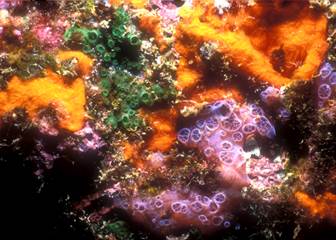
|
|
Cnidarians; mostly called “corals”
by hobbyists, are similarly removed from
wild-collected live rock; mostly to
comply with country and international
(CITES) stipulations. Indeed, some LR
purveyors list their shipments as “Misc.
Scleractinia” to avoid confiscation
should some small colonies pass
undetected by their staff. As with
die-backs in your system, even just a
bit of tissue can recover under good
care. Here’s an apparent stony coral
skeleton… in Wakatobi, S. Sulawesi.
|

|
|
Ascidians; aka Sea Squirts along
with sponges make up about half the
biomass on and in live rock. Again, they
too are “whacked off” in processing the
rock for shipment, for the same reasons
as Sponges…. And this is a great shame.
This “almost vertebrate” life is very
beautiful and interesting biologically.
IF you can get “very good/fresh” live
rock, you may find live Sea Squirts
popping up on it in time. Here in N.
Sulawesi, Indo.
|
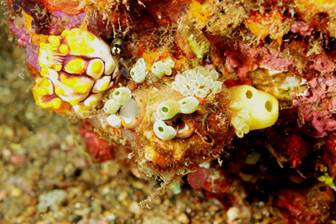
|
More Specialized HHs:
|
Heck; we’re running out of time
and space! Am desirous of listing
Waminoa species flatworms as they’re so
common; occurring on many species of
stony (here on Plerogyra on the right)
and soft (on a Sarcophyton below). As
with Bristleworms, folks used to lose
their minds on encountering these.
Again, here comes the pitch for
isolating all incoming…. And if you have
a bunch at stake, or are in the biz,
using preventative dips/baths to prevent
introducing these dang pests. Too late?
Siphoning them off their hosts, the
rock, substrate helps… there are some
natural predators (mostly small
Labrids), and though dangerous to use,
Anthelminthics that will poison ALL
worms, and possibly other life… that one
can use. Be ready to do massive water
changes should this use poison your
system.
|
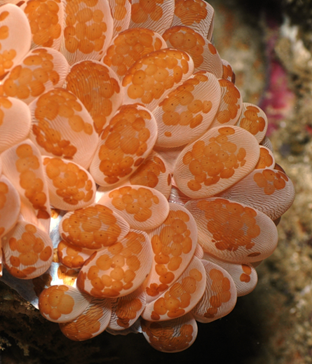
|
|

|
Got Giant Clams? Maybe Pyramid Snails As Well!
|
Pyramidellid snails can make their
way into a system on other hard
materials, but most all are errantly
introduced with infested Tridacnid
Clams. Oh yes; they’re no fun. Again,
best excluded by careful isolation of
new Clams, examination of their byssus
area, and cursory removal with sharp
forceps in processing ahead of their
introduction to main/displays. There are
predators that will eat these pest
snails, but they can easily damage the
byssus, possibly killing the clam.
|

|
Cloze:
Where are the rest?! Where are the Red Bugs, the Coral Eating
Nudibranchs; this can’t be all? Well, actually…. The above accounting
may well not be surprising to you; and for sure there are MANY more
hitchhikers we could chat about. Don’t fear the Reaper or them. Instead,
get and use a solid quarantine protocol to keep most out from the get
go; and be aware of what to look for in the way of accidental
introduction; sensible control. As with other aspects of marine aquarium
keeping, nothing good happens quickly with hitchhikers.
|
|

